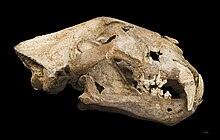

The history of lions in Europe is part of the wider history of the lion species complex. The rediscovery and confirmation of their presence in Europe, already known by myths, historical accounts and ancient art, was made possible by the finds of fossils of Pleistocene, Holocene and Ancient lions excavated in Europe since the early 19th century.[1][2] The first excavated lion fossil was found in southern Germany, and described by Georg August Goldfuss using the scientific name Felis spelaea. It probably dates to the Würm glaciation, and is 191,000 to 57,000 years old.[3] Since then, older lion skull fragments were excavated in Germany and in other parts of Europe, including in Western Europe. Some of them were described by Wilhelm von Reichenau under Felis fossilis in 1906.[4]
The oldest remains of lions in Europe, assigned to the species Panthera fossilis, are over 600,000 years old. This species represents one of the largest known felines to have ever existed, with this species eventually evolving into the smaller (around the size of a modern lion) cave lion (Panthera spelaea),[5] which is widely depicted in Palaeolithic European art like cave paintings.[6] Remains of P. fossilis and P. spelaea are known from across Europe.[5] Cave lions became extinct around 14,000 years ago at the end of the Pleistocene.[7] During the early-middle Holocene (from around 8,000 years ago) modern lions colonised Southeast and parts of Central and Eastern Europe, before becoming extinct in Europe during classical times.[8]
Lions have appeared in European literature since the times of Ancient Greece, such as in the Iliad, or with the story of the Nemean lion.[9] Ancient Greeks also depicted them in sculpture, such as with the Lion Gate of Mycenae or in the island-sanctuary of Delos, where various sculptures of lions survive to this day.[10]
It is believed that most of them were killed by humans during Ancient history, notably by hunting or by using them in public games. During the Roman Republic and later Roman Empire, using lions in gladiatorial games and public spectacles was a prized endeavor. These practices likely contributed significantly to the decline and eventual disappearance of lions from Europe.
- ^ Diedrich, C.G. (2011). "The largest European lion Panthera leo spelaea (Goldfuss 1810) population from the Zoolithen Cave, Germany: specialised cave bear predators of Europe". Historical Biology. 23 (2–3): 271–311. Bibcode:2011HBio...23..271D. doi:10.1080/08912963.2010.546529. S2CID 86638786.
- ^ Bartosiewicz, L. (2009). "A Lion's share of attention: Archaeozoology and the historical record". Acta Archaeologica Academiae Scientiarum Hungaricae. 60 (1): 759–773. doi:10.1556/AArch.59.2008.2.28.
- ^ Diedrich, C.G. (2008). "The holotypes of the upper Pleistocene Crocuta crocuta spelaea (Goldfuss, 1823: Hyaenidae) and Panthera leo spelaea (Goldfuss, 1810: Felidae) of the Zoolithen Cave hyena den (South Germany) and their palaeo-ecological interpretation". Zoological Journal of the Linnean Society. 154 (4): 822–831. doi:10.1111/j.1096-3642.2008.00425.x.
- ^ Reichenau, W. V. (1906). "Beiträge zur näheren Kenntnis der Carnivoren aus den Sanden von Mauer und Mosbach". Abhandlungen der Großherzoglichen Hessischen Geologischen Landesanstalt zu Darmstadt. 4 (2): 125.
- ^ a b Marciszak, Adrian; Gornig, Wiktoria (September 2024). "From giant to dwarf: A trend of decreasing size in Panthera spelaea (Goldfuss, 1810) and its likely implications". Earth History and Biodiversity. 1: 100007. doi:10.1016/j.hisbio.2024.100007.
- ^ Russo, G.; Milks, A.; Leder, D.; Koddenberg, T.; Starkovich, B. M.; Duval, M.; Zhao, J.-X.; Darga, R.; Rosendahl, W.; Terberger, T. (2023). "First direct evidence of lion hunting and the early use of a lion pelt by Neanderthals". Scientific Reports. 13 (1): 16405. Bibcode:2023NatSR..1316405R. doi:10.1038/s41598-023-42764-0. PMC 10570355. PMID 37828055.
- ^ Stuart, A. J. & Lister, A. M. (2011). "Extinction chronology of the cave lion Panthera spelaea". Quaternary Science Reviews. 30 (17): 2329–2340. Bibcode:2011QSRv...30.2329S. doi:10.1016/j.quascirev.2010.04.023.
- ^ Marciszak, A.; Ivanoff, D. V.; Semenov, Y. A.; Talamo, S.; Ridush, B.; Stupak, A.; Yanish, Y.; Kovalchuk, O. (2022). "The Quaternary lions of Ukraine and a trend of decreasing size in Panthera spelaea". Journal of Mammalian Evolution. 30 (1): 109–135. doi:10.1007/s10914-022-09635-3. hdl:11585/903022.
- ^ Alden, M. (2005). "Lions in paradise: Lion similes in the Iliad and the Lion Cubs of IL. 18.318-22". The Classical Quarterly (55): 335–342. doi:10.1093/cq/bmi035.
- ^ Hermary, Antoine (2020-12-01). "Sculptures archaïques de Délos : deux lions, une sirène et deux oiseaux". Bulletin de correspondance hellénique (in French). 144 (1). doi:10.4000/bch.1045. ISSN 0007-4217. Archived from the original on 2024-08-17. Retrieved 2024-08-17.